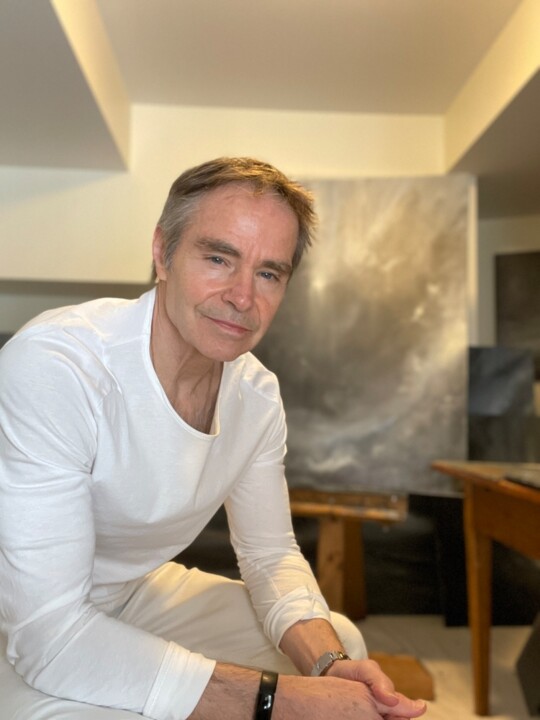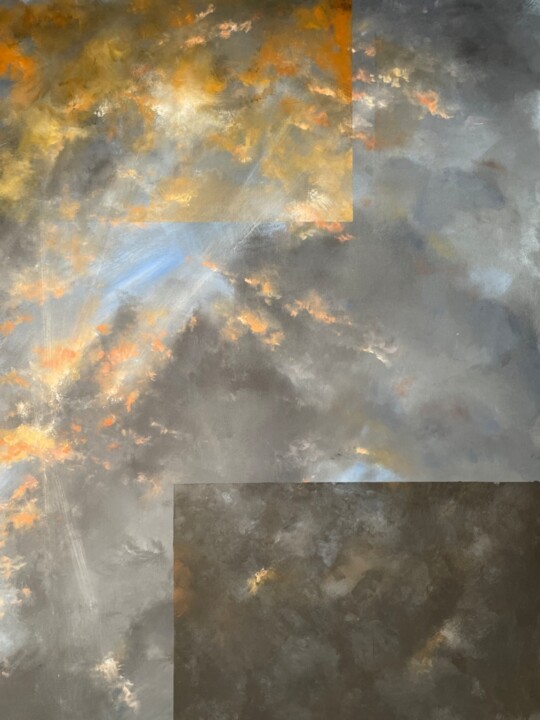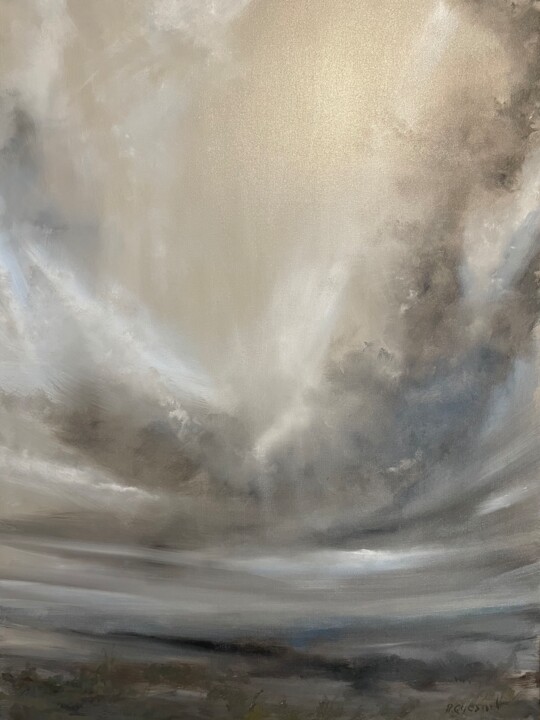As a small boy, I was always a bit of a daydreamer - much to my school teacher’s chagrin. I could use my imagination quite well. I was always fascinated with my environment and the nature that surrounded me. And so, as a result, from a very young age I started to draw and sketch things of nature - trees, fields, clouds etc.. Also, my father fought for the Canadian army in WWII - he landed on D-Day and fought in Normandy - and so I was fascinated with drawing war pictures and battle scenes. Often I would stay up most of the night drawing - so excited with adrenaline to finish my picture. It was from that time that my love to create art started and I knew I would be an artist for the rest of my life, whether as a chosen career or not. I studied art all through high school under the guidance and mentorship of artist and teacher Samuel Saunders and further went on to study Fine Arts at York University in Toronto. I have been trained in painting with oils, acrylics, watercolour and egg tempera. I painted for decades with oils, but now use acrylics exclusively. I’ve done silk screen, sculpture (clay, metal, wood and plaster) and have had extensive drawing and painting training and experience throughout my whole life. For me, drawing and painting have gone hand in hand all my life. I never considered myself very good at drawing, but I was always very good at shading and I think this has helped me a lot as a painter - to better understand light, tone, shade and depth.What inspired you to create art and become an artist? (events, feelings, experiences...)
What are the 3 aspects that differentiate you from other artists, making your work unique?
I create all of my paintings purely from my imagination and completely intuitively as I paint. I have a general sense of the image I want to paint beforehand, but my main focus and thoughts as I paint, are more about the mood, atmosphere or the feeling I want to convey. It’s about emotion, through emotive application of the paint - whether it be through light, shade, form, colour or brushwork. That’s what dictates my actions as I am creating the image.
I use large brushes to complete 90% of each painting.I rarely have human beings in my paintings. My paintings are only about nature itself and not the presence of man.
Where does your inspiration come from?
Largely from within. What I mean is that I get inspired by images that just pop into my head - whether it’s big grey, moody skies, or vast distant landscapes or soft, smooth light colours or dark misty images - they just appear to me in thought or even as I am falling asleep at night. I don’t know where these images come from - perhaps forgotten memories or images I’ve seen from the past, or dreams I’ve had - they just appear and very vividly most of the time. All of these images tend to be of nature, not people or things. Mostly vast skies, clouds, landscapes - more ethereal images.
What is your artistic approach? What visions, sensations or feelings do you want to evoke in the viewer?
I am best known for large, dramatic cloudscapes and big-sky, broad-horizon skyscapes. My goal in each painting is to capture the “spirit” of the scene. To create a feel, a mood for the viewer. I am not so interested in creating “pretty”, representational paintings, so much as I am more concerned with capturing the emotion of the image. My paintings are all about conveying an atmosphere or mood, in hopes of evoking an emotional encounter with the viewer. They are about creating an ethereal sensation for them. I want the viewer to stop and be drawn into my work - to use their imagination and become part of the image. I want them - if only briefly - to get lost in meditative reflection. Perhaps forgotten moments, memories or feelings they’ve had. If I’ve done this for the viewer, then I feel I’ve done my job as an artist.
What is the process of creating your works? Spontaneous or with a long preparatory process (technical, inspiration from art classics or other)?
I paint very, very quickly. I paint intuitively and expressively. I paint with larger brushes and apply the paint with emotive brushstrokes to build the forms and the mass of the painting quickly. This allows me to feel the image coming alive quickly and helps me convey the emotions or thoughts I have on canvas quicker. I use heavy glazing with my paints which enable me to manipulate the paint for better blending and softer edges. I then move to mops for further soft blending and then to smaller filbert brushes to provide subtle hard edges. I try to achieve that “right” balance between soft and hard edges in all of my paintings. Although I paint quickly and expressively, the basis of my technique comes from academics in classical painting.
Do you use a particular work technique? if so, can you explain it?
Yes. Before I even put paint to canvas, I coat the entire canvas with medium liquid glaze. This allows me to blend and “sculpt” my initial shapes, forms and tones much easier and faster at the start of my painting. I follow the same process in my approach to every painting. Since I like to blend my paint on canvas, I like to use a lot of glaze with my acrylics. I also like to use large brushes in a dry-brush technique to create a misty, hazy smooth quality which gives the image an atmospheric feel.
Are there any innovative aspects in your work? Can you tell us which ones?
I think I’ve answered this question pretty well in my previous answers:
- all paintings painted intuitively, made up from my imagination - pre-coat entire canvas with liquid glaze - all paintings done mostly with large brushes (90% of the image)- extensive dry-brushing blending technique used with large brushes
Do you have a format or medium that you are most comfortable with? if yes, why ?
Acrylic paints. They are easy to blend and manipulate - provided you mix them with retarders or glazes. And of course they are less messy than working with oil paints and easier to clean up without the use of solvents.
Where do you produce your works? At home, in a shared workshop or in your own workshop? And in this space, how do you organize your creative work?
I have a full studio at home. I angle my easel within it to obtain optimal natural light from the window. As well, I have additional overhead light and lamps for further lighting effects if needed. I hang many canvases on the walls of the studio as well as leaned up against the walls all around. I group them in series to give a gallery effect. To see all my paintings displayed, gives me a comforting feeling and helps my creative inspiration when I paint.
Does your work lead you to travel to meet new collectors, for fairs or exhibitions? If so, what does it bring you?
Not so much, except for the local gallery that represents me (Biggs Art Gallery, Aurora, Canada).
How do you imagine the evolution of your work and your career as an artist in the future?
I think I want to let myself be open to experimentation with technique and method. I don’t want to be afraid to take risks as an artist. I want to push myself, stretch my skills and my technique as I continue to create. I have a style that is my own and I want to keep it and improve on it. I will always continue to make art the way I want to make it - as long as it can also make my viewer feel something. I wiil of course be inspired by other artists, but I will continue to stay true to my style and hone it further.
What is the theme, style or technique of your latest artistic production?
Large canvas, atmospheric cloudscapes and broad-horizon skyscapes. This series is all about mood and atmosphere. Its about creating an ethereal, dreamlike image, where hopefully the viewer can get lost in meditative thought and allows them to escape. I’ve created them, with the same technique and style as with all of my work - impressionistic, loose-brush, soft edges, moody, misty and with a subdued, refined, muted colour palette.
Can you tell us about your most important exhibition experience?
It’s really only through my gallery that I exhibit.
If you could have created a famous work in the history of art, which one would you choose? And why ?
Edgar Degas’ The Absinthe Drinker. It’s my favourite painting. He has captured the feeling and melancholy of the scene so beautifully. There’s something forlorn and so sad about the woman that just enraptures me with such sadness for her. Her look - so lost and despondent. Her shoulders - slumped down. How she weakly slouches forward, looking hopeless, while her eyes stare off blankly - glazed from half-drunkenness and the gaze of regret. Her partner, hobo-like, looking the other way, oblivious to the suffering of the woman beside him. It makes me want jump into the painting to console her and tell her that everything will be ok. The painting moves me so deeply with such sadness.
If you could invite one famous artist (dead or alive) to dinner, who would it be? How would you suggest he spend the evening?
For me, it would have to be Turner. He’s my favourite artist of all-time and a big influence on my painting style. I just love the way he captures the light in his paintings and says so much with so little in his works. He’s so masterful at capturing diffused light and the spirit of the scene without spelling out all the details for his viewer. I would love to discuss his inspirations and thoughts about his works - his approach to a painting, his technique, materials etc. Finally, after dinner I would suggest we go for a long walk in the country fields to watch the sun setting and to ask him his thoughts on the view and what he sees.






 Olimpia Gaia Martinelli
Olimpia Gaia Martinelli












